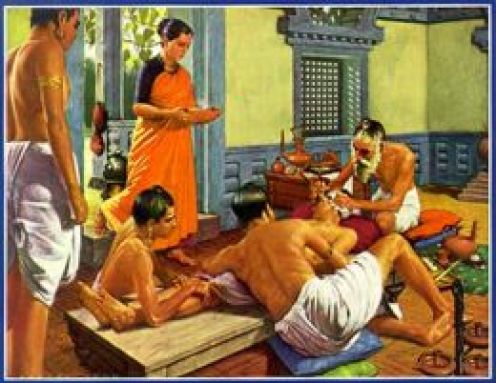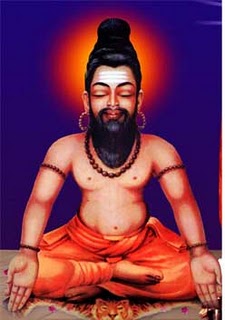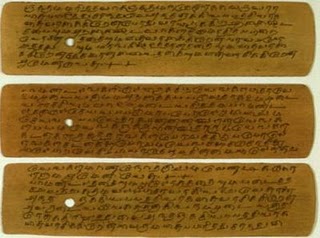 A Satguru that I've been studying suggests the mantra "Aum Saravanabhava" for those not yet initiated by a guru instead of the "Aum Namah Sivaya" mantra. I understand that Lord Murugan is the 2nd son of Siva but would like to know more about the mantra and more about the Lord. The Satguru suggests that this is the mantra to chant for one aspiring the guidance of a guru.
A Satguru that I've been studying suggests the mantra "Aum Saravanabhava" for those not yet initiated by a guru instead of the "Aum Namah Sivaya" mantra. I understand that Lord Murugan is the 2nd son of Siva but would like to know more about the mantra and more about the Lord. The Satguru suggests that this is the mantra to chant for one aspiring the guidance of a guru.What Is the Nature of Lord Karttikeya?
SLOKA 24
Lord Karttikeya, Murugan, first guru and Pleiadean master of kundalini yoga, was born of God Siva's mind. His dynamic power awakens spiritual cognition to propel souls onward in their evolution to Siva's feet. Aum
BHASHYA
Lord Karttikeya flies through the mind's vast substance from planet to planet. He could well be called the Emancipator, ever available to the call of those in distress. Lord Karttikeya, God of will, direct cognition and the purest, child-like divine love, propels us onward on the righteous way through religion, His Father's law. Majestically seated on the manipura chakra, this scarlet-hued God blesses mankind and strengthens our will when we lift to the inner sky through sadhana and yoga. The yoga pada begins with the worship of Him. The yogi, locked in meditation, venerates Karttikeya, Skanda, as his mind becomes as calm as Saravana, the lake of Divine Essence. The kundalini force within everyone is held and controlled by this powerful God, first among renunciates, dear to all sannyasins. Revered as Murugan in the South, He is commander in chief of the great devonic army, a fine, dynamic soldier of the within, a fearless defender of righteousness. He is Divinity emulated in form. The Vedas say, "To such a one who has his stains wiped away, the venerable Sanatkumara shows the further shore of darkness. Him they call Skanda." Aum Namah Sivaya.
What Does Lord Karttikeya's Vel Signify?
SLOKA 25
The lancelike vel wielded by Lord Karttikeya, or Skanda, embodies discrimination and spiritual insight. Its blade is wide, long and keen, just as our knowledge must be broad, deep and penetrating. Aum Namah Sivaya.
BHASHYA
The shakti power of the vel, the eminent, intricate power of righteousness over wrongdoing, conquers confusion within the realms below. The holy vel, that when thrown always hits its mark and of itself returns to Karttikeya's mighty hand, rewards us when righteousness prevails and becomes the kundalini serpent's unleashed power thwarting our every effort with punishing remorse when we transgress dharma's law. Thus, the holy vel is our release from ignorance into knowledge, our release from vanity into modesty, our release from sinfulness into purity through tapas. When we perform penance and beseech His blessing, this merciful God hurls His vel into the astral plane, piercing discordant sounds, colors and shapes, removing the mind's darkness. He is the King of kings, the power in their scepters. Standing behind the temporal majesty, He advises and authorizes. His vel empowering the ruler, justice prevails, wisdom enriches the minds of citizens, rain is abundant, crops flourish and plenty fills the larders. The Tirumurai says, "In the gloom of fear, His six-fold face gleams. In perils unbounded, His vel betokens, 'Fear not.'" Aum Namah Sivaya.
Let us know that Supreme Being and meditate upon Him, the Supreme General of the great deva army. May He enlighten us and lead us to be one with Him, Lord Skanda.Krishna Yajur Veda, Taittiriya Aranyaka 10.6.2-3 (Shanmukha Gayatri). LW, 112
In the heart of those who recount His name, He reveals His gracious feet. Thus He appears to those who chant the hallowed name Murugan. He stands immanent in all.Tirumurai 11, Nakkirar. KD, 224
The moon, sun and fire are in unison radiating their resplendent effulgence. Radiating the luminous sparks is Murugan, who lights up the world by His peerless light.[i]Kathirgama Purana. KD, 220
Murugan, Kumaran, Guhan -- to utter and melt and have divine experience -- when shall Thou grant this, O guru supreme, worshiped by the devas devout and mortals alike, O abode of virtues eight!Kandar Anubhuti 15. KA, 116
The First-born Son of Shiva-Shakti grew from Rudra’s fiery seed that fell into Gangama, and was known as Skanda.
He is Karttikeya: too intense for Shri Ganga to bear, he was consigned to the rushes on her bank (cf. Moses).
Rudra-Shiva is guardian of the Unmanifest, and the conception of Manifestation was accidental. That first conception was perfect and pure ~ a virgin birth of a perfect reality ~ and from the inert expanse of perfect Ideas (the Mind of God, and the very body of Lord Shiva) is born the perfect incarnation, the ideal form, the physical form of the Ideal, an Avatara.
Shiva and Shakti remain in eternal coitus; but in worldly legend, the device of Spilled (Skanda) Seed (Bija) preserves the maidenhood of the Devi. That fiery Bija is the Pranava, a product of Shiva's great Tapasya, which was deposited into Shri Ganga. Her immortal flow could not actually bear its intense heat; and to preserve Her own perfection, Skanda was driven to Her side, where he dwelled in the vegetation until his true nature was recognized by the six Karttikas, who kindled his light and raised the youthful spark up to a blazing reality.
The six Matrikas (recognized as Adityas and known as the Karttika sisters, whose constellation rules the harvest month of Karttika) were sent to kill infant Skanda; although, lactating at his sight, they nursed him, and named him Karttikeya, who became the six-headed commander of the legions of Rudra. The Matsya-Purana (c. 1000 AD) lists some 190 bloodthirsty Matrikas, created by Shiva to defeat the demon Andhaka. Karttikeya became the supreme commander of this hysterical host. His emblem is the blue-necked peacock, and it is perhaps amalgamation with the Karttikeya-cult (which was presumably not achieved without conflict) that gave Shiva his blue throat (Nilakantha).
The Adityas are generally counted as six or seven. Six is the number of spatial cardinals (East, West, North, South, Zenith, and Nadir); and, just as the prime number five is reserved for Shiva, the esoteric seventh point at the heart of this six-fold symmetry came to be understood as the transcendent seat of Shakti.
In Yoga, the Son becomes the equal of his Father, since their Light is ultimately One Light. Shiva and Skanda are but the source of light and the light itself; both the sacrificial fire and its essential nature, which are an effectively inseparable conjoined twin. And Shakti is Power ~ the Power of transformation, without which the Vision could not be made Flesh ~ so that all three of the Father, the Mother, and the Child, together frame the original nuclear family.
Karttikeya, just like his father, has a connexion with Keshin, and it is the action of the potent poison of all the worlds’ evil, which was churned from the primal ocean by Vayu (the Wind, father of the ancient storm-god Rudra) that is often given in explanation of Nilakantha Shiva, who held the venom in his throat and survived.
Shiva, Shakti, and Skanda, are but three forms of essential Fire, or Agni; and Agni is Rudra, and both Agni and Rudra are known as Tryambaka.
The Mahabharata mentions Rohitaka (modern Rohtak District, in Haryana) as the home of Karttikeya, who was tutelary deity of the ferocious orgiastic Mattamayuraka tribe (Matta = Drunk).
Although Karttikeya has received orthodox acceptance and royal patronage, his cultic origins have been retained by the Kanphata (Split Ear ~ from their initiatory insertion of large Kundala through the centre of each ear) Yogins, who worship the Samadhi of Mastnatha (Intoxicated Lord) at Astal Bohar, near Rohtak. Every night, three huge pipes are prepared for Mahayogi Mastnatha and his two assistants, and I am assured that every morning they are found to have been fully smoked. The Panjab Census Report (1891) described their annual Mela (Fair) as disreputable.
source: http://www.hindudharmaforums.com/showthread.php?t=590

















 .Panchamirtham is made by mixing ripe bananas, honey, sugar candies , ghee and dates. The taste is simply out of the world. It is available in bottles for Rs.25 each or tin cans of Rs.30 each.
.Panchamirtham is made by mixing ripe bananas, honey, sugar candies , ghee and dates. The taste is simply out of the world. It is available in bottles for Rs.25 each or tin cans of Rs.30 each.



 . For their typical customers ( mostly villagers), that would be an irrestible sight but I didnot want to risk tasting all the dust on the pooris !
. For their typical customers ( mostly villagers), that would be an irrestible sight but I didnot want to risk tasting all the dust on the pooris !







